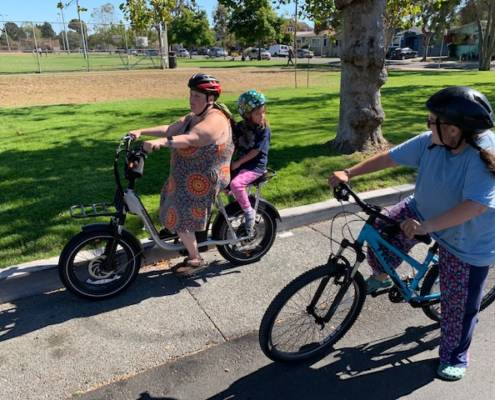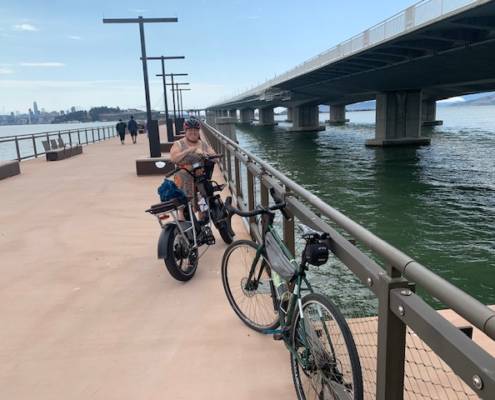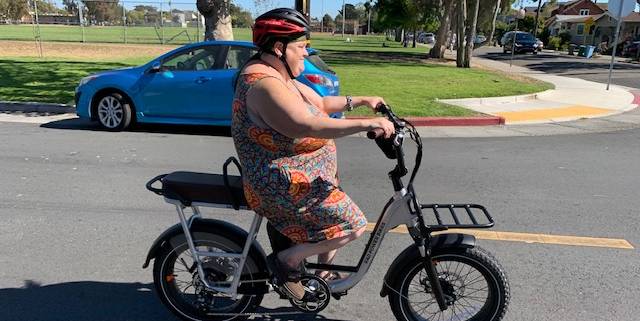How to Get a Clean Cars for All E-Bike Voucher in the Bay Area
During a recent meeting of the CARB Electric Bicycle Incentives Work Group, the comments made it evident that there are lots of Californians trying to figure out how to get help to afford an e-bike. The incentives program, which CalBike helped pass last year, will provide vouchers to low-income Californians for an e-bike purchase. When it comes online in early 2023, it will offer incentives of $750 to $1,500 toward an e-bike purchase.
However, if you don’t want to wait and you have an old car you’re ready to get rid of, you may qualify for a considerably higher voucher to buy e-bikes for multiple family members. A few years ago, CalBike got the Clean Cars for All program to include vouchers to purchase an e-bike as one of the options (the program offers incentives of up to $9,500 toward an electric car for people who turn in an older, gas-powered vehicle).
It’s not straightforward to figure out how to get a Clean Cars e-bike voucher, and each local air management district administers its own program, so there may be regional differences. We spoke with Berkeley resident Vicki Davis about her experience getting a voucher and a new e-bike through the program administered by the Bay Area Air Quality Management District (BAAQMD).
An e-bike that solves two problems

During the pandemic, Davis’ older daughter went on bike rides with her dad for her PE requirement. Davis couldn’t join them because she has asthma and other health issues that would make it hard for her to keep up. Plus, she didn’t have a bike. Her younger daughter hasn’t learned to ride, so the two of them were stuck at home while the other half of their family had all the fun.
Her family had another problem: A 2000 Camry, her husband’s old car, with an unreliable battery. “Over the pandemic, he really got into biking and was using his car less and less,” she says, “and we would get tickets almost every month for street sweeping.”
The Clean Cars for All program solved both problems. Davis was able to take the Camry off the road, and, in return, the program gave her a voucher to buy one or more e-bikes. “We got $7,500, which is more than we could have gotten [for the Camry] had we sold it,” she says. She and her husband don’t have to worry about parking tickets, registration, or getting the car to pass smog. And Davis has a brand new Rad Runner Plus that allows her to keep up with her husband and older daughter and take her younger child for a ride on the back.
Here are the basics of the Clean Cars for All e-bike voucher program, including the timing and tips from Davis on navigating the process.
Step 1: Have an eligible car to trade and meet eligibility requirements
To qualify for a Clean Cars for All voucher, you must meet the program’s eligibility requirements. In the Bay Area, that includes living in an eligible zip code, meeting the income requirement (income within 400% of the Federal Poverty Level), owning a car that falls within the program parameters, and being a first-time applicant to the program.
The car must be drivable to qualify. Davis’ Camry had 180,000 miles on it and was in decent condition, but she was happy to scrap it. “It was basically like paying rent to have it parked on our street,” she says.
Step 2: Fill out lots of paperwork
“The very first step is preapproving that you can even apply,” Davis says. That part of the process was quick.
Once she was preapproved, she could submit paperwork proving her income and ownership of the car. The website was not mobile-friendly, which presented an extra challenge.
When her husband found out about the program through a post on Twitter, he didn’t believe it was real, but he sent her the information, and she submitted the application because they were desperate to get rid of their second car. It took so long for her to hear back from BAAQMD that she figured it wasn’t real or the program had run out of money, but she finally got approved.
She submitted paperwork through an online portal where she could check her application status and can now check the balance on her voucher and get purchases approved.
Pro Tip: Davis notes that the program promotes itself as a subsidy to buy an EV, and it’s harder to find the e-bike option. In the Bay Area, that option is listed under Mobility Options, which includes a grant for transit passes. When you choose what kind of voucher you want, it looks like you’re opting for a transit pass — the e-bike grant is in small print.
Step 3: Get the car inspected at a salvage yard.
“I think a lot of the delays were me, to be honest,” Davis says. It took her a while to complete the many steps of the process, and, she adds, scrapping the car was a whole second chore that she hadn’t bargained on. She had to get the battery working to drive the vehicle to the salvage yard for inspection.
There was an issue with the yard sending her documents through to the Clean Cars program, and getting the information sent again was a big hassle. Her tip: “Keep copies of things. Follow up.”
Step 4: Wait.
Davis found out she was eligible to apply for a Clean Cars voucher in March of 2021. She submitted her paperwork in April. Her status changed to Under Review in July and Approved in November.
Step 5: Take the car back to be junked.
After she was approved, Davis took her car to be junked in November. It took a few more weeks for the grant to come through; she got her voucher in late December of 2021.
Step 6: Buy your new e-bike, accessories, and more
Davis bought a Rad Runner Plus Class 2 e-bike for about $2,100, including tax and accessories. “The thing I really like about the one I got is that it has a seat on the back for my younger daughter,” she says.
She chose the Rad Runner even though her voucher would have enabled her to get a more expensive e-bike because it fit her style better. She likes having the throttle option so she can keep going if she gets too tired.
The voucher is on a pre-loaded credit card, and Davis can submit what she wants to buy beforehand to get it pre-approved or approved after the purchase. She must load receipts for each purchase and show that it’s related to her e-bike. When she needed an extension cord for charging and bought a milk crate for an inexpensive basket, she had to load photos of the items in use since they weren’t classified as bike accessories.
With the $4,600 she has left, she can buy e-bikes for other family members, and she’s going to see if she can get a bike rack to put her e-bike on the back of the family car. She also has the option to convert the balance into money for transit passes. The program gives her up to three years to spend the funds.
Step 7: Ride everywhere and have a blast!

Davis is having a great time riding her new e-bike with her husband and kids. “We rode over the Bay Bridge, which was so exciting,” she says. She’s been taking her younger daughter to and from school by bike and riding alongside her older daughter to Berkeley High.
“Even though it’s an electric bike and I use the assist, I am getting exercise,” Davis says. Some of the things she loves about being able to bike now include “going places where we don’t have to worry about parking” and “not having to stress about my second car.” She’s getting less nervous about riding and expanding her comfort zone; she recently did her first ride in the dark.
If you think you might qualify for the Clean Cars for All program and would like an e-bike voucher, check the program webpages for information on where to apply in your region. And you can out more details about the Bay Area program on this handy reference page.





